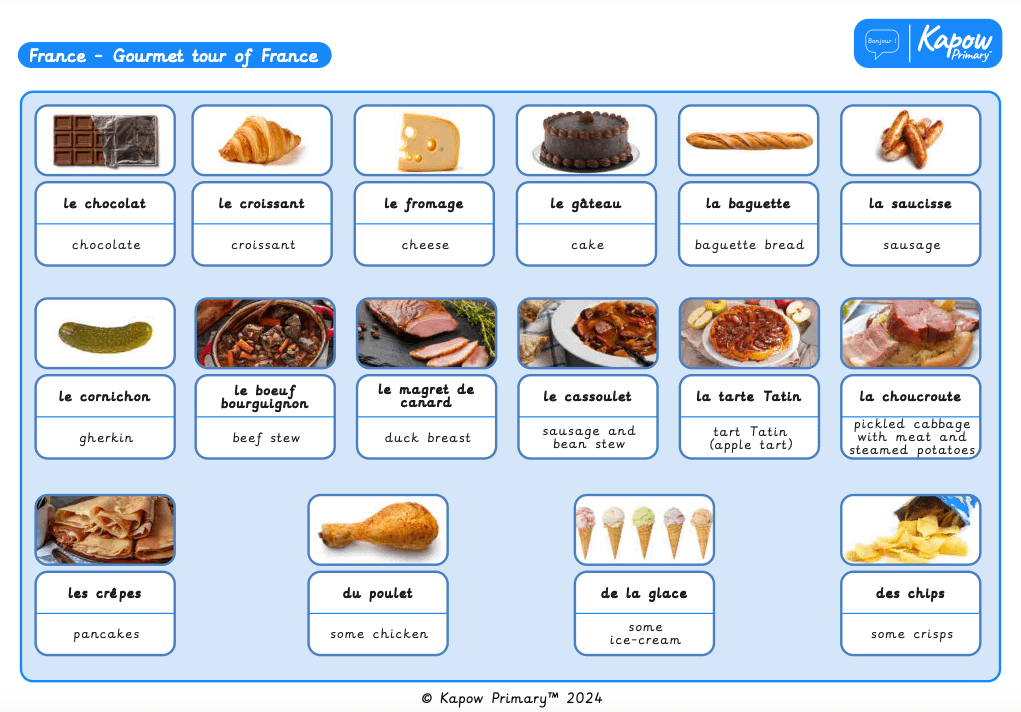Primary Theme: Food
Lesson 5: Producers, predators and prey in food chains
Understanding feeding relationships between animals and the effect this has on population size.
We’re monitoring the upcoming 2025 National Curriculum updates and will revise our resources when we know more. Learn more
- Subjects >
- Science >
- Lower key stage 2 >
- Year 4 >
- Animals including humans: Digestion and food >
-
Lesson 5: Producers, predators and prey in food chains
Are you ready to start the lesson?
We’re monitoring the upcoming 2025 National Curriculum updates and will revise our resources when we know more. Learn more
- Subjects >
- Geography >
- Lower key stage 2 >
- Year 4 >
- Where does our food come from? >
- Lesson 5: Are our school dinners locally sourced? >
-
Lesson 5: Are our school dinners locally sourced?: Presentation mode
Lesson 5: Are our school dinners locally sourced?
Discussing and designing data collection methods for qualitative data and conducting an interview.
We’re monitoring the upcoming 2025 National Curriculum updates and will revise our resources when we know more. Learn more
- Subjects >
- Geography >
- Lower key stage 2 >
- Year 4 >
- Where does our food come from? >
-
Lesson 5: Are our school dinners locally sourced?
Y3/4 (A): Lesson 6: Poo clues
Exploring how biologists use faeces to find out about animals’ diets and constructing results tables to record observations. This lesson is part of the mixed-age scheme.
We’re monitoring the upcoming 2025 National Curriculum updates and will revise our resources when we know more. Learn more
- Subjects >
- Science >
- Mixed-age >
- Y3/4 (A): Animals, including humans: Digestion and food >
-
Y3/4 (A): Lesson 6: Poo clues
Lesson 6: Balanced diets
Exploring Science in action to see how scientific research has contributed to modern advice. This lesson is part of the mixed-age scheme.
We’re monitoring the upcoming 2025 National Curriculum updates and will revise our resources when we know more. Learn more
- Subjects >
- Science >
- Mixed-age >
- Y3/4 (A): Animals, including humans: Movement and nutrition >
-
Y3/4 (A): Lesson 6: Balanced diets
Y3/4 (B): Unit 6: Gourmet tour of France
Use this unit hub to inform your medium-term plan and navigate to related resources.
We’re monitoring the upcoming 2025 National Curriculum updates and will revise our resources when we know more. Learn more
Unit outcomes
Pupils who are secure will be able to:
- Listen and respond to single words, short phrases and full sentences.
- Follow a short text or rhyme, listening and reading at the same time.
- Recognise some familiar French words in written form.
- Begin to understand and notice cognates and near cognates.
- Begin to explore various language detective strategies.
- Use a bilingual dictionary to find the meaning of unknown words and check the spelling of unfamiliar words.
- Use visual and contextual clues to make predictions about the meaning of unfamiliar vocabulary.
- Discuss similarities and differences between customs and traditions in France and the UK.
- Discover French festivals and their traditions.
- Order typical French food and/or drink.
Suggested prior learning
Y3/4 (B): Unit 5: Fabulous French food
Get startedLessons
Y3/4 (B): Lesson 1: Favourite French foods
- To ask and respond to a question about food.
Y3/4 (B): Lesson 2: Regional French food
- To use a range of opinion verbs and adjectives.
Y3/4 (B): Lesson 3: Monsieur Mangetout’s French food week
- To perform a short story about food using words and actions.
Y3/4 (B): Lesson 4: Shopping in France – how much?
- To describe the quantity of food nouns.
Y3/4 (B): Lesson 5: French detectives in the kitchen
- To explore and understand an authentic French text.
Key skills
Key knowledge
Related content
Unit resources

Knowledge organiser: French – Y3/4 Gourmet tour of France
Aimed at pupils, two pages providing key facts and definitions from the unit 'Y3/4 (B): Unit 6: Gourmet tour of…
Cross-curricular opportunities
Mathematics
Statistics
Pupils should be taught to:
- Interpret and present data using bar charts, pictograms and tables.

